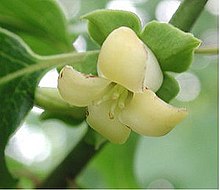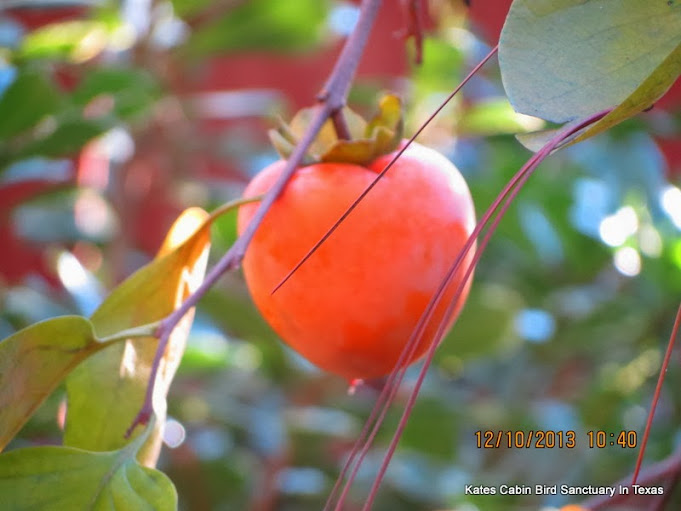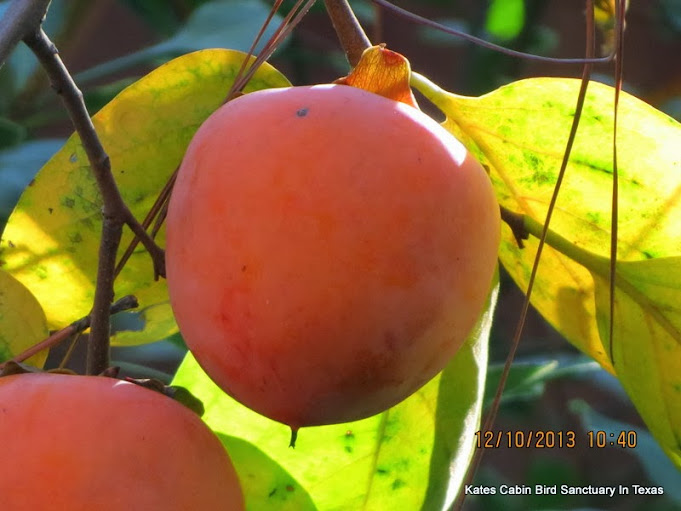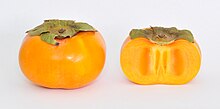

Hi Everybody!!
Real winter weather has settled into South Texas like it has been here forever. In the old days, these cold fronts would roll in and just as quickly roll out, leaving the sun to warm up the air. Weather is different in present time, and I haven't seen the sun in days. Temperatures are hovering around 34 degrees so the Angels are not yet frozen! The good thing about this cold is the persimmons are now ripe and yummy! I have shared info below from Wikipedia about the Persimmon, my favorite fall tree and fruit. Enjoy!




Link to Photostudy in G+Album Gallery:
https://plus.google.com/u/0/photos/117645114459863049265/albums/5955540937322020145




https://en.wikipedia.org/wiki/Persimmon
Persimmon
From Wikipedia, the free encyclopedia
Persimmons are the edible fruit of a number of species of trees in the genus Diospyros.Diospyros is in the family Ebenaceae. The most widely cultivated species is the Asian persimmon, Diospyros kaki. In color the ripe fruit of the cultivated strains range from lightyellow-orange to dark red-orange depending on the species and variety. They similarly vary in size from 1.5 to 9 cm (0.5 to 4 in) in diameter, and in shape the varieties may be spherical, acorn-, or pumpkin-shaped.[1] The calyx generally remains attached to the fruit after harvesting, but becomes easy to remove once the fruit is ripe. The ripe fruit has a high glucose content. The protein content is low, but it has a balanced protein profile. Persimmon fruits have been put to various medicinal and chemical uses.
Like the tomato, persimmons are not popularly considered to be berries, but in terms ofbotanical morphology the fruit is in fact a berry.
| Persimmon | |
|---|---|
 | |
| Persimmon flower | |
| Scientific classification | |
| Kingdom: | Plantae |
| (unranked): | Angiosperms |
| (unranked): | Eudicots |
| (unranked): | Asterids |
| Order: | Ericales |
| Family: | Ebenaceae |
| Genus: | Diospyros |
Names and etymology[edit]
The word Diospyros comes from the ancient Greek words "Dios" (διός) and "pyros" (πυρος). In context, this means more or less "divine fruit", though its literal meaning is closer to "Wheat of Zeus".[2][3] It is, however, sufficiently confusing to have given rise to some curious interpretations, such as "God's pear" and "Jove's fire". The Modern Greek name for the fruit is λωτός (lotos) which leads modern Greeks to the assumption that this is the lotos referred to in Homer's Odyssey.
The word persimmon itself is derived from putchamin, pasiminan, or pessamin, from Powhatan, an Algonquian language of theeastern United States, meaning "a dry fruit".[4]
Diospyros virginiana (American persimmon)[edit]
American persimmon (Diospyros virginiana) is native to the eastern United States and is higher in nutrients like vitamin C, calcium, iron and potassium than the Japanese Persimmon. Its fruit is traditionally eaten in a special steamed pudding in the Midwest and sometimes its timber is used as a substitute for ebony (e.g. in instruments).
Fruit[edit]
Commercially and in general, there are two types of persimmon fruit: astringent and non-astringent.
The heart-shaped Hachiya is the most common variety of astringent persimmon. Astringent persimmons contain very high levels of soluble tannins and are unpalatably astringent (or "furry" tasting) if eaten before completely softened. However, the sweet, delicate flavor of fully ripened persimmons of varieties that are astringent when unripe, is particularly relished. The astringency of tannins is removed in various ways. Examples include ripening by exposure to light for several days, and wrapping the fruit in paper (probably because this increases the ethylene concentration of the surrounding air). Ethylene ripening can be increased in reliability and evenness, and the process can be greatly accelerated, by adding ethylene gas to the atmosphere in which the fruit are stored. For domestic purposes the most convenient and effective process is to store the ripening persimmons in a clean, dry container together with other varieties of fruit that give off particularly large quantities of ethylene while they are ripening; apples and related fruits such as pears are effective, and so are bananas and several others. Other chemicals are used commercially in artificially ripening persimmons or delaying their ripening. Examples include alcohol and carbon dioxide which change tannin into the insoluble form. Such bletting processes sometimes are jumpstarted by exposing the fruit to cold or frost. The resultant cell damage stimulates the release of ethylene, which promotes cellular wall breakdown.
One traditional misconception is that persimmons are to be ripened till rotten. This is a confusion of the processes of controlled ripening with the processes of decay, possibly arising from problems of translation from Asiatic languages onto English. Rotting is the action of microorganisms such as fungi, and rotting persimmons are no better than any other rotting fruit. Sound persimmons should be ripened till they are fully soft, except that the carpels still might be softly chewy. At that stage the skin might be splitting and the calyx can easily be plucked out of the fruit before serving, which often is a good sign that the soft fruit is ready to eat.
Astringent varieties of persimmons also can be prepared for commercial purposes by drying. Tanenashi fruit will occasionally contain a seed or two, which can be planted and will yield a larger more vertical tree than when merely grafted onto the D. virginianarootstock most commonly used in the U.S. Such seedling trees may produce fruit that bears more seeds, usually 6 to 8 per fruit, and the fruit itself may vary slightly from the parent tree. Seedlings are said to be more susceptible to root nematodes.
The non-astringent persimmon is squat like a tomato and is most commonly sold asfuyu. Non-astringent persimmons are not actually free of tannins as the term suggests, but rather are far less astringent before ripening, and lose more of their tannic quality sooner. Non-astringent persimmons may be consumed when still very firm, and remain edible when very soft.
There is a third type, less commonly available, the pollination-variant non-astringent persimmons. When fully pollinated, the flesh of these fruit is brown inside—known asgoma in Japan—and the fruit can be eaten firm. These varieties are highly sought after and can be found at specialty markets or farmers markets only.[citation needed] Tsurunoko, sold as "chocolate persimmon" for its dark brown flesh, Maru, sold as "cinnamon persimmon" for its spicy flavor, and Hyakume, sold as "brown sugar" are the three best known.
Before ripening, persimmons usually have a "chalky" taste or bitter taste.
| Nutritional value per 100 g (3.5 oz) | |
|---|---|
| Energy | 531 kJ (127 kcal) |
| Carbohydrates | 33.5 g |
| - Sugars | n/a |
| - Dietary fiber | n/a |
| Fat | 0.4 g |
| Protein | 0.8 g |
| Vitamin C | 66 mg (80%) |
| Calcium | 27 mg (3%) |
| Iron | 2.5 mg (19%) |
| Phosphorus | 26 mg (4%) |
| Potassium | 310 mg (7%) |
| Sodium | 1 mg (0%) |
Trees[edit]
The trees of all species have stiff, tumescent leaves, but the female of the D. virginianacan look less turgid than the male because the leaves droop when fruiting, perhaps because of the heavier nutrient requirements. They grow swiftly, and are resilient to the stresses of unpredictable climates. Persimmons can tolerate and adapt to a wide range of climates. Persimmons are also known for their resistance to diseases and pests. They are one of the last trees to leaf out in the spring, and do not flower until well after the leaves have formed, bypassing the threat of blossom loss to frosts. The fruit hangs on the branches long into the winter. Because they grow swiftly and colonize off their root systems, they are ideal for helping recover habitat. A persimmon tree will be mature enough to bear fruit within 7–8 years. They hold their own against flooding riverbanks quite well and are listed in Stormwater Journal's list of water-holding trees.[25]
Please see link for complete article




Link to persimmon photostudy in G+ Album:


Creek. See You next time! Stay Warm!

O+O





No comments:
Post a Comment
Hi Everybody! Please say hello and follow so I know you are here! Due to the inconsideration of people trying to put commercials on my blog comment area, I have restricted use of anonymous posts. Sorry that some hurt all.
My public email is katescabin@gmail.com No spammers or trolls